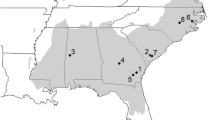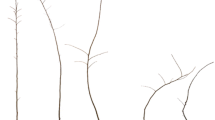Abstract
A quantitative genetic model, that uses known family structure with clonal replicates to separate genetic variance into its additive, dominance and epistatic components, is available in the current literature. Making use of offspring testing, this model is based on the theory that components of variance from the linear model of an experimental design may be expressed in terms of expected covariances among relatives. However, if interactions between a pair of quantitative trait loci (QTLs) explain a large proportion of the total epistasis, it will seriously overestimate the additive and dominance variances but underestimate the epistatic variance. In the present paper, a new model is developed to manipulate this problem by combining parental and offspring material into the same test. Under the condition described above, the new model can provide an accurate estimate for additive x additive variances. Also, its accuracy in estimating dominance and total epistatic variances is much greater than the accuracy of the previous model. However, if there is obvious evidence showing the major contribution of high-order interactions, especially among ≥ 4QTLs, to the total epistasis, the previous model is more appropriate to partition the genetic variance for a quantitative trait. The re-analysis of an example from a factorial mating design in poplar shows large differences in estimating variance components between the new and previous models when two different assumptions (lowvs high-order epistatic interactions) are used. The new model will be an alternative to estimating the mode of quantitative inheritance for species, especially for longlived, predominantly outcrossing forest trees, that can be clonally replicated.
Similar content being viewed by others
References
Ahuja MR, Libby WJ (1993) Clonal forestry I. Genetics and biotechnology. Springer-Verlag, Berlin Heidelberg
Becker WA (1984) Manual of Quantitative genetices, 4th edn. Academic Enterprises. Pullman, Washington
Bradshaw HD Jr, Stettler RF (1995) Molecular genetics of growth and development in Populus. IV. Mapping QTLs with large effects on growth, form, and phenology traits in forest tree. Genetics 139:963–973
Bryant EH, Meffert LM (1992) The effect of serial founderflush cycles on quantitative genetic variation in the housefly. Heredity 70:122–129
Bryant EH, McCommas SA, Combs LM (1986) The effect of an experimental bottleneck upon quantitative genetic variation in the housefly. Genetics 114:1191–1211
Cannell MGR, Sheppard EJ, Cahalan C (1988) C effects and second generation clone performance in Picea sitchensis and Pinus contorta. Silvae Genet 37:15–19
Carson HE, Templeton AR (1984) Genetic resolutions in relation to speciation phenomena: the founding of new populations. Annu Rev Ecol Syst 15:97–131
Cockerham CC (1954) An extension of the concept of partitioning hereditary variance for analysis of covariance among relatives when epistasis is present. Genetics 39:859–882
Cockerham CC (1956) Effects of linkage on the covariances between relatives. Genetics 41:138–141
Cockerham CC (1963) Estimation of genetic variances. In: Hanson WD, Robinson HF (eds) Statistical genetics and plant breeding. Proc Natl Acad Sci Natl Res Council USA 982:53/2-94
Comstock RE, Kelleher T, Morrow EB (1958) Genetic variation in an asexual species, the garden strawberry. Genetics 43:634–646
Crow JF, Kimura M (1970) An introduction to population genetics theory. Harper and Row, New York
Damerval C, Maurice A, Josse JM, deVienne D (1994) Quantitative trait loci underlying gene product variation: a novel perspective for analyzing regulation of genome expression. Genetics 137:289–301
Dempster ER (1942) “Mock dominance” Science 97:464–465
deViente MC, Tanksley SD (1993) QTL analysis of transgressive segregation in an interspecific tomato cross. Genetics 134:585–596
Doebley J, Stec A (1991) Genetic analysis of the morphological differences between maize and teosinte. Genetics 129:285–295
Doebley J, Stec A (1993) Inheritance of the morphological differences between maize and teosinte: comparison of results for two F2 populations. Genetics 134:559–570
Falconer DS (1989) Introduction to quantitative genetics, 3rd edn. Longman, Harlow, England
Farmer RE Jr, Freitag M, Garlick K (1989) Genetic variance and “C” effects in balsam poplar rooting. Silvae Genet 38:62–65
Fisher RA (1918) The correlations between relatives on the supposition of Mendelian inheritance. Trans Roy Soc Edin 52:399–433
Foster GS (1990) Genetic control of rooting ability of stem cuttings from lobolly pine. Can J For Res 20:1361–1368
Foster GS, Shaw DV (1988) Using clonal replicates to explore genetic variation in a perennial plant species. Theor Appl Genet 76:788–794
Frampton LJ Jr, Foster GS (1993) Field testing vegetative propagules. In: Ahuja MR, Libby WJ (eds) Clonal forestry I. Genetics and biotechnology. Springer-Verlag, Berlin Heidelberg, pp 110–134
Goodnight CJ (1987) On the effect of founder events on epistatic genetic variance. Evolution 41:80–91
Goodnight CJ (1988) Epistasis and the effect of founder events on the additive genetic variance. Evolution 42:399–403
Griffing B (1990) Use of a controlled-nutrient experiment to test heterosis hypotheses. Genetics 126:753–767
Hallauer AR, Miranda JB (1988) Quantitative genetics in maize breeding, 2nd edn. Iowa State University Press, Ames, Iowa
Hayman BI (1958) The separation of epistatic from additive and dominance variation in generation means. Heredity 12:371–390
Hayman BI, Mather K (1955) The description of genie interaction in continunous variation. Biometrics 10:69–82
Jinks JL, Jones ZM (1958) Estimation of the components of heterosis. Genetics 43:223–234
Libby WJ, Jund E (1962) Variance associated with cloning. Heredity 17:533–540
Mather K (1949) Biometrical genetics. Methuen, London
Mather K, Jinks JL (1982) Biometrical genetics, 3rd edn. Chapman and Hall. London
Minvielle F (1987) Dominance is not necessary for heterosis: a two-locus model. Genet Res 49:245–247
Mullin TJ, Park JS (1992) Estimating genetic gains from alternative breeding strategies for clonal forestry. Can J For Res 22:14–23
Mullin TJ, Park JS (1994) Genetic parameters and age-age correlations in a clonally replicated test of black spruce after 10 years. Can J For Res 24:2330–2341
Mullin TJ, Morgenstern EK, Park JS, Fowler DP (1992) Genetic parameters from a clonally replicated test of black spruce (Picea mariana). Can J For Res 22:24–36
Paterson AH, Damon S, Hewitt JD, Zamir D, Rabinowitch HD, Lincoln SE, Lander S, Tanksley D (1991) Mendelian factors underlying quantitative traits in tomato: comparison across species, generations, and environments. Genetics 127:181–197
Provine WB (1986) Sewall Wright and evolutionary biology. University of Chicago Press, Chicago
Richey FD (1942) Mock-dominance and hybrid vigor. Science 96:280–281
Rönnberg-Wästljung AC, Gullberg U, Nilsson C (1994) Genetic parameters of growth characters in Salix viminalis growth in Sweden. Can J For Res 24:1960–1969
Schnell FW, Cockerham CC (1992) Multiplicative vs arbitrary gene action in heterosis. Genetics 131:461–469
Stuber CW, Lincoln SE, Wolff DW, Helentjaris T, Lander ES (1992) Identification of genetic factors contributing to heterosis in a hybrid from two elite maize inbred lines using molecular markers. Genetics 132:823–829
Tachida H, Cockerham CC (1989) A building block model for quantitative genetics. Genetics 121:839–844
Tanksley SD (1993) Mapping polygenes. Annu Rev Genet 27:205–233
Templeton AR (1979) The unit of selection in Drosophila mercatorum. II. Genetic revolution and the origin of coadapted genomes in parthenogenetic strains. Genetics 92:1265–1282
Templeton AR (1980) The theory of speciation via the founder principle. Genetics 94:1011–1038
Wade MJ (1992) Sewall Wright: gene interaction and the shifting balance theory. Oxf Surv Evol Biol 8:33–62
Williams W (1959) Heterosis and the genetics of complex characters. Nature 184:527–530
Wright S (1922) The effect of inbreeding and crossbreeding on guinea pigs. III. Crosses between highly inbred families. Tech Bull US Dept Agric 1121
Wright S (1932) The roles of mutation, inbreeding, crossbreeding, and selection in evolution. Proc 6th Int Congr Genet 1:356–366
Wright S (1980) Genie and organismic selection. Evolution 34:825–843
Wu R (1995) A quantitative genetic model of mixed diploid and triploid progenies in tree breeding and evolution. Theor Appl Genet 90:683–690
Author information
Authors and Affiliations
Additional information
Communicated by J. MacKey
Rights and permissions
About this article
Cite this article
Wu, R.L. Detecting epistatic genetic variance with a clonally replicated design: models for lowvs high-order nonallelic interaction. Theoret. Appl. Genetics 93, 102–109 (1996). https://doi.org/10.1007/BF00225734
Received:
Accepted:
Issue Date:
DOI: https://doi.org/10.1007/BF00225734




